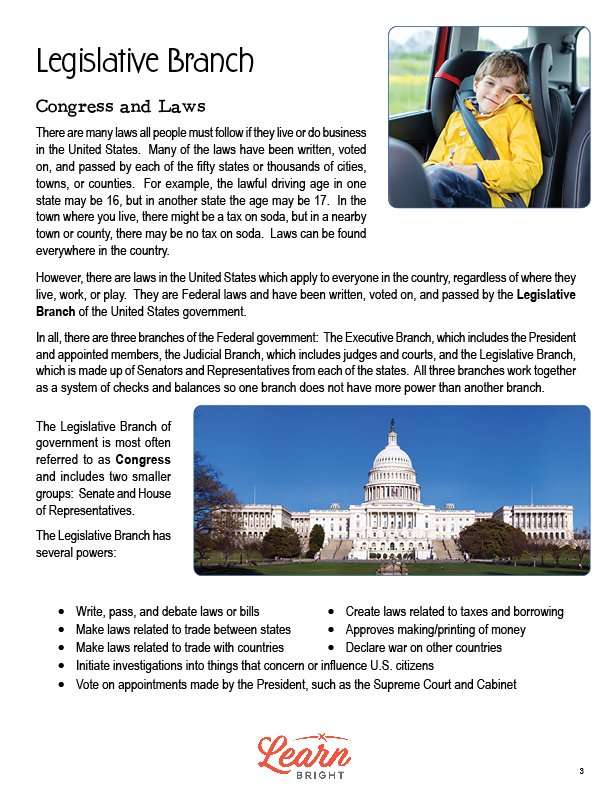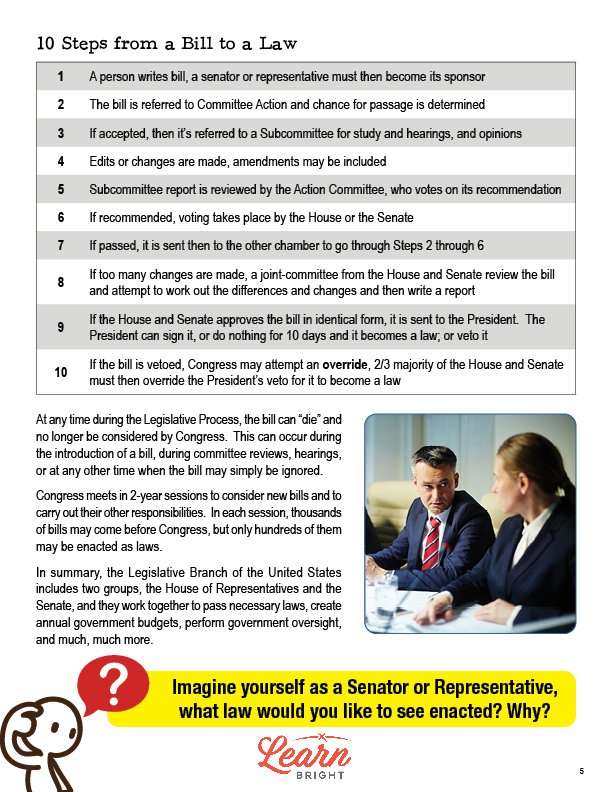Description
What our Legislative Branch lesson plan includes
Lesson Objectives and Overview: Our Legislative Branch lesson plan introduces students to the Legislative Branch of the United States. Most students are familiar with some parts of the world of politics and government but are usually unsure of the two parts that make up Congress, the House, and the Senate. At the end of the lesson, students will be able to define the legislative branch of the U.S. government and identify and explain its roles and responsibilities. This lesson is for students in 4th grade, 5th grade, and 6th grade.
Classroom Procedure
Every lesson plan provides you with a classroom procedure page that outlines a step-by-step guide to follow. You do not have to follow the guide exactly. The guide helps you organize the lesson and details when to hand out worksheets. It also lists information in the red box that you might find useful. You will find the lesson objectives, state standards, and number of class sessions the lesson should take to complete in this area. In addition, it describes the supplies you will need as well as what and how you need to prepare beforehand.
Options for Lesson
Included with this lesson is an “Options for Lesson” section that lists a number of suggestions for activities to add to the lesson or substitutions for the ones already in the lesson. To adjust the lesson activity, you can change the group sizes or shorten or lengthen the Legislative Process. For an addition to the lesson, you can invite a Senator or representative to speak to your class about the Legislative Branch. If you’re teaching this lesson during an election season, you can discuss the current candidates running in your area. Finally, if you have more than one class section, you can have one be the Senate and the other be the House.
Teacher Notes
The teacher notes page includes a paragraph with additional guidelines and things to think about as you begin to plan your lesson. This page also includes lines that you can use to add your own notes as you’re preparing for this lesson.
LEGISLATIVE BRANCH LESSON PLAN CONTENT PAGES
Congress and Laws
The Legislative Branch lesson plan includes three content pages. In the United States, we have laws that all people must follow when they live or do business. The states, cities, towns, and counties all across the U.S. have written, voted on, and passed these laws. In one state, the legal driving age could be 16, while it could be 17 in another state. Your town might have a tax on soda, but the next town over might not have one. We can find laws all over the country.
However, some laws apply to everyone, regardless of which state they live or work in. We call these Federal laws. The Legislative Branch of the United States government wrote, voted on, and passed them.
We have three different branches of government in the United States: the Executive Branch (includes the President and appointed members), the Judicial Branch (includes judges and courts), and the Legislative Branch (includes the Senators and Representatives from each state). The three branches work together and use a system of checks and balances to make sure one branch doesn’t have more power than another.
We often refer to the Legislative Branch as Congress. Two smaller groups, the Senate and the House of Representatives, make it up.
The Legislative Branch has many different powers. They write, pass, and debate laws and bills; make laws related to trade between states and with other countries; initiate investigations into things that concern or influence U.S. citizens; vote on appointments made by the President, like the Supreme Court and Cabinet; create laws related to taxes and borrowing; approve the making and printing of money; and declare war on other countries.
House of Representatives
The House of Representatives is the largest Congressional group, consisting of 435 men and women representing all of the 50 states. Each state has a certain number of representatives based on their population. If you have more people living in your state, you have more representatives in the House.
40 million people live in California, so they have 53 representatives. Only one million people live in Rhode Island, so they only have two representatives. Seven states have only one representative. The total number of representatives does not change, but the number for each state can change once they complete the census, the official count of the population, every ten years.
The House and the Senate both play roles in making and passing laws, but their roles are different.
The House may begin the process of writing and passing laws related to taxes. They can also make decisions related to government officials who have committed a crime against the country. They can also place them on trial before the Senate. To be a representative, you must be at least 25 years old and must have been a U.S. citizen for the past 7 years. Representatives can serve an unlimited number of 2-year terms.
Senate
The Senate has 100 members, two from each state. In the Senate, each state has equal representation.
The Senate can vote for or against treaties the President makes with other countries and the people the President recommends to the Supreme Court, cabinet members, and ambassadors to other countries. They can hold a trial for government officials who have committed a crime against the country. To be a senator, you must be at least 30 years old and must have been a U.S. citizen for the past 9 years. Senators can serve an unlimited number of 6-year terms.
Passing Laws
The Senate and House of Representatives create new laws every year. Both the Senate and the House must agree on these laws using the Legislative Process, the steps involved in creating a law. Before a law becomes a law, we call it a bill.
10 Steps from a Bill to a Law
There are ten steps to go from a bill to a law. First, someone writes a bill and a senator or representative must sponsor it. Second, they refer the bill to Committee Action and they determine its chance for passage. Third, if accepted, they then refer it to a Subcommittee for further study, hearings, and opinions. Fourth, they make edits and changes and include any amendments. Fifth, the Action Committee reviews the subcommittee report and votes on its recommendation. Sixth, if recommended, the House or Senate votes.
Seventh, if passed, they send the bill to the other chamber, where it repeats steps two through six. Eighth, if they made too many changes, a joint committee with people from both the House and Senate review the bill, make changes, and write a report. Ninth, if the House and Senate approve identical versions of the bill, they send it to the President. The President either passes it by either signing it doing nothing for ten days, or vetoes it. Tenth, if the President vetoes the bill, Congress can override the veto with a 2/3 majority of the House and Senate, making it a law.
The bill can “die” at any time during these steps. This can happen during its introduction, during committee reviews, or at any other time.
Congress considers bills and carries out their other responsibilities during 2-year sessions. Thousands of bills might come before Congress during these sessions, but only hundreds might become laws.
The Legislative Branch of the government includes two groups, the House and the Senate. They work together to pass laws, create government budgets, do government oversight, and more.
LEGISLATIVE BRANCH LESSON PLAN WORKSHEETS
The Legislative Branch lesson plan includes three worksheets: an activity worksheet, a practice worksheet, and a homework assignment. You can refer to the guide on the classroom procedure page to determine when to hand out each worksheet.
BILL CREATION ACTIVITY WORKSHEET
Students will work with a group to complete a five-part activity worksheet. You can find full instructions on the worksheet. Students will first write a summary of a bill that they would like to introduce to Congress and will give it to the teacher. They will then work with their group to review some of the bills submitted by their classmates. They will discuss, debate, and vote on the bills. The class will then split into two Senate and two House Committees to discuss and debate the bills.
Following this, the two Senate and two House Committees will merge. The new House Committee will vote on the bills approved by the Senate committees and the new Senate Committee will vote on the bills approved by the House committees. The teacher can, at this point, veto any bills they want. In this case, the House and Senate will try to override the veto. Finally, students will work in pairs to answer questions about this process. They will share their thoughts with the class as part of a group discussion to end the activity.
MATCHING PRACTICE WORKSHEET
The practice worksheet asks students to first match lesson vocabulary with their definitions. Next, they will number each step in the Legislative Process in the correct order from 1 to 10.
LEGISLATIVE BRANCH HOMEWORK ASSIGNMENT
For the homework assignment, students will first tell whether each fact refers to the House of Representatives, the Senate, or both. They will then answer ten questions about the lesson material.
Worksheet Answer Keys
This lesson plan includes answer keys for the practice worksheet and the homework assignment. If you choose to administer the lesson pages to your students via PDF, you will need to save a new file that omits these pages. Otherwise, you can simply print out the applicable pages and keep these as reference for yourself when grading assignments.









